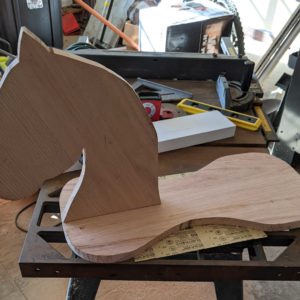I’m new to woodworking and am trying to build my daughter a rocking horse out of red oak. What is the best joint to use to connect the horse’s head to the body (see attached image)? The wood is 3/4″ thick. My initial thought was that a simple dowel joint would be easiest; however, I’m a bit worried about the joint strength, and so I’m also considering a mortise & tenon joint (perhaps reinforced with 1/4″ dowels, since I’d have to reduce the width of the head to create the joint).
Any ideas would be appreciated!
















Replies
A dowel joint is a mortise and tenon joint, just with round rather than rectangular mortises and tenons. It's weak compared to the rectangular versions because the round parts can ovalise slightly, making the glue joint break.
Mortise and tenon of the rectangular sort would work well, especially if you made the tenons through tenons and wedged them, for a mechanically strong joint rather than one just relying on the glue. You could use multiple smaller wedged tenons for that horse.
Another possibility is to use cut nails, put in from the bottom with their heads buried in the wood to prevent them catching & scratching. Cut nails are remarkably tenacious.
Lataxe
A second vote for mortise & tenon, with 2 modifications...
First, break the joint into at least 3 parts to leave some "webbing" to reduce the chance of splitting. Second, add some thickness at the base of the head to spread the force or your daughter over a wider area.
If you make the segmented M&T joint and drive a coupla screws from below into the "collar" at the base of the horse's neck it should be bombproof enough to get passed down to your grandkids.
I would also recommend M&T. However, make the tenon almost full thickness with only a minimal shoulder on each side (maybe 1/8"). This leaves a tenon with the max amount of meat on it. Also, make the tenon go all the way through the "seat". After that, I think your only concern would be possible splitting of the "seat" at the front. You can combat this by starting the M&T a couple of inches back from the front edge of the neck. Also, you might consider a short cross-grain spline on the bottom side just below the front edge. If you leave the tenon as thick as possible, I'm not sure that thickening the base of the neck would be necessary. However, it's a great idea if you decide to use loose tenons or dowels.
I'd like to see more of this. Does the horse's body not extend below the head? If it does, it both complicates things and provides solutions. Some sort of half lap with the body/head and seat would make a connection and support.
I haven't connected anything yet, but I'm going to be adding a support piece beneath the saddle / body that the legs will connect to (similar to the attached image from this YouTube video: https://www.youtube.com/watch?v=jNkn6uH2z8I) for some extra support
Very nice. Give it eyes. It's creepy without eyes.
The pic is helpful. If it were me, I would slot out the area below the head, in the topmost body part. When the top and bottom of the body are assembled, that will be like a mortise for the head. Glue in the head, then add screws from underneath.
Hope that's clear.
Makes sense, thanks @John_C2!
One thing to consider here. The head appears to be vertical grain running across. That would mean your tenons would be edge gain. Wood trends to split easily along its long grain, hence why tenons ( and dove tails) are usually done cross grain. I'd be concerned about the tenon breaking along the grain. In this case dowel joints may be more appropriate.
The OP's picture of his own horse head, in the first post, shows the grain of the head entering the flat part (body/seat) at an angle, unlike that of the horse in the example video pic-extraction. With a supporting piece beneath the body/seat providing more "meat" for tenons on the head-piece to insert into, that should be a strong joint.
The tenons and mortises could also be angled to run with the grain of the head - but that would be rather more complicated to make.
Lataxe
This forum post is now archived. Commenting has been disabled